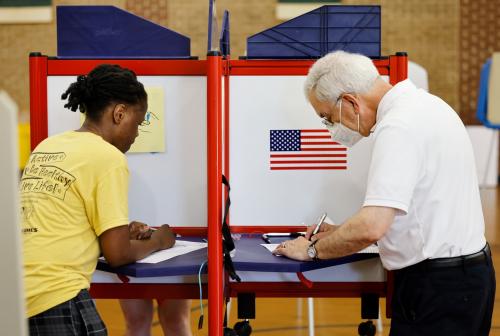I fell in love by accident. It was 1959 and I was writing a book with my mentor from Johns Hopkins, Malcolm Moos. It would be called Hats in the Ring: The Making of Presidential Candidates. The problem was that it was too thin for the price Random House wished to charge. It needed padding. So off I went to the Library of Congress to find filler. There I met curator Milton Kaplan, who opened my eyes to the vast resources of the prints and photographs collections. Ben Franklin was the first American cartoonist! Paul Revere drew cartoons when colonists couldn’t afford to buy his silverware! Currier & Ives cartooned contentedly for competing sides in any dispute, including slavery! There were the cartoonists in combat with the bosses. Thomas Nast vs. William Tweed. Homer Davenport vs. Mark Hanna. Plus the presidents who must have been created especially for cartoonist’s pen: Abe Lincoln and Teddy Roosevelt.
Kaplan convinced me that the world needed a history of American political cartoons. After about twenty rejections, Macmillan decided to take a chance. The Ungentlemanly Art was published in 1968, complete with illustrated endnotes. A second edition in 1975 took advantage of the cartooning wealth produced by Watergate.
Cartoons became for me an endless gift when Sandy Northrop, a prize-winning filmmaker, won a NEH award to create a series on American political cartoons for PBS and invited me to co-author a companion book. Although the TV series was not produced, our book was published as Drawn & Quartered (1996). And now there is a new edition from Transaction, American Political Cartoons: The Evolution of a National Identity, 1754-2010.
Part of the joy of these projects has been the opportunities to observe and otherwise fraternize with the artists whose livelihood is making public figures look ridiculous. In 1965 I set out across country, first to California, where Paul Conrad had the year before left the Denver Post for the Los Angeles Times. It was a Friday. We had a lunch date. I arrived early, which might have been distracting in that Conrad had to produce cartoons for Sunday and Monday. The Chinese had just exploded their first nuclear device. “What do you think of this?” He handed me a sketch of little men holding up a huge missile, with the caption, “Chinese explode first nuclear-guided muscle.” I replied, “The Chinese have a bomb because they’ve got a lot of nuclear scientists, not because they’ve got a lot of coolies.” (This now sounds nasty, which it wasn’t meant to be.) Conrad sketched again, another idea, then another sketch. I think he never sat down. Finally he was satisfied and we left for lunch. I had never before seen a frenzy of creativity.
From Los Angeles, I went on to Denver, where Conrad had been succeeded by a young man from Adelaide, Australia, Pat Oliphant, who after a year in the U.S. had won the Pulitzer Prize. Oliphant came over to my hotel to explain this rare feat. At the time the Pulitzer was given for a single cartoon, rather than for a portfolio as is now the case. Pat found a book of the winners—Gerald Johnson’s The Lines are Drawn—and analyzed until he was sure what the judges want, and then draw a cartoon designed solely for that purpose. The cartoon shows Ho Chi Minh, holding a dying Vietnamese child in his outstretched arms, saying, “They won’t get us to the conference table…will they?” I guess a great cartoonist is permitted one hackneyed idea. In 1976 I was part of a panel on the MacNeil-Lehrer program (it was then a half-hour), during which Oliphant sat in a corner drawing cartoons to illustrate the points we were making. We opined for twenty minutes, during which time Pat created six cartoons! My point is that great cartoonists—Conrad and Oliphant are in that category—seem to have some mental equipment that instantly turns particulars into powerful or funny visual images.
The 1960s was the perfect time for me to begin exploring political cartooning. After eight years of Eisenhower keeping the calm, the country was a cartoonist’s dream. In eight panels, Jules Feiffer lets a dancer tell the decade’s story: “A dance to 1967/In this dance I have symbolized a nation in flux/Establishing fresh approaches to the problems of poverty/Crime in the streets/Vietnam/and civil rights./A dance to 1967.” In the final panel she is in a fetal position clutching a revolver (Village Voice, January 1, 1967).
Two great examples during this period illustrate what my colleague Sandy Northrop says is how “simplicity belies the complexity of the art form, reducing the event through eloquent use of caricature and juxtaposition into its essence.” In 1966 Lyndon Johnson pulled up his shirt to show reporters his scar from a recent gallbladder operation. David Levine turned the scar into the shape of Vietnam, thus exposing the president’s and the nation’s deeper wound (The New York Review of Books, May 12, 1966). The other cartoon was Bill Mauldin’s response to the killing of President Kennedy. Here the seated Lincoln at the Washington mall bows his head, covers his face, depicting the nation’s grief (Chicago Sun-Times, November 23, 1963).
Looking back, a wonderful perch at the Brookings Institution for nearly four decades has allowed me to write books I have wanted to write, almost equally divided by subject between the presidency and the news media; for sheer fun, however, I recommend political cartoons.



Commentary
Op-edMy Love Affair with Political Cartoons
January 10, 2011